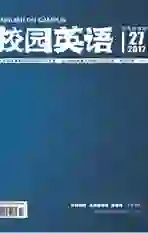EnglishReadingTeachingBasedonSchemaTheory
2017-09-06朱熹
朱熹
【Abstract】Reading is the main way for human to gain information. Chinese English learners contact more with foreign language information in the form of reading than any other ways. Furthermore, reading comprehension plays an important role in all kinds of tests, and understanding of the other parts of tests also needs certain ability of reading. At present, the factors that affect the reading for Chinese students can be summarized as the following, insufficient vocabulary, inadequate comprehension, and lack of the relative encyclopedic knowledge, etc. Besides, most students found that they pay more and gain less after a great mounts of reading practice. In view of these problems, the thesis discusses some reading teaching methods based on schema theory, and helps the students to grasp some reading techniques contributing to improving their reading ability.
【Key words】 English reading teaching; schema theory
1. Introduction
Carrell holds that reading is the most important purpose of learning a foreign language. Both first language and second language learners know the importance of reading, and they are struggling to find a better and more effective way to read. As a teacher, I am more than willing to cultivate students reading thinking. The thesis aims to explain the process of reading thinking, focus on how to build schema and search teaching reading methods based on schema theory.
2. Definition of Schema
The concept of “schema” is put forward by philosopher Kant as early as 1781. Schema, he argues, is a product of the imagination, and the mediation of sensibility and rationality. In his theory, there are two key words which we should pay attention: experience and creation.
Then the concept will be heightened a theoretical stature, which is exactly credited to Gestalt psychology. Bartlett is regarded as the father of schema theory. In his famous book Remembering: A Study in Experimental and Social Psychology, he defines schema as “an active organization of past reactions, or past experience.”
American artificial intelligence expert Rumelhart (1977) explains the schema theory systematically and roundly. He regards it as a theory about how knowledge is represented in ones mind and used. He thinks schema is a set of “interplays of cognitive structures” or “constitutions of architecture bricks of cognitive abilities”, stored in long-term memory hierarchically. He considers that the existing schema can influence or control the understanding of new information. So according to schema theory, when people try to learn new things, they need to connect acquired concepts and past experience (background knowledge) with new things. Based on the theory, he puts forward a reading mode used to research the psychological process of reading.
1980s, with the development of schema theory, lots of linguistics tend to apply schema theory into foreign language teaching and explain the process of psychological language. Though there are different concepts in expressing schema theory, they have a lot of common features which refer to the same phenomenon in the process of cognitive psychology. Huang Jianlin (2004) points out the five characteristics of schema: (1) Schema has specific examples. Schema can be activated and schematized, when we found a specific sample of schema in real world. (2) Schema can be embedded into each other. That means a schema can be composed of several schemas and also be a part of others. (3) Schema can represent knowledge on all abstract level. If there are abstract schemata such as “freedom” and “science” can be represented. The concrete schemata like “wheel” and “car” can also be done. (4) Schema has a great effect on perceiving the world and understanding the language. (5) Schema has dynamic characteristics, and it can be enriched and enlarged with the growth of the world knowledge.
3. Types of Schema
According to readers reading abilities, schema can be divided into three types by its theory, namely language schema, content schema and formal schema.
3.1 Language Schema
Linguistic schema refers to readers existing basic language knowledge such as vocabulary, phrase, the structure of sentence, the related grammar. Building linguistic schema is vital for grasping and understanding basic language knowledge, which is the precondition of reading comprehension.
A reader can not recognize words, phrases, and sentences without related language schema, let alone mobilize content schema and formal schema in brain through the information and clues of texts. So he or she certainly can not comprehend the text. For most poor English learners, the most obstacle of reading is the deficiency of vocabulary, sentence and grammar knowledge, and the text information can not be input. Therefore, at the beginning of learning English, teacher should pay attention to cultivate their language schema, and attach importance to the learning of vocabulary and grammar. They should not spend much time in translating the text word by word, but analyze the long and complicated sentence structures and help the students to understand them.
3.2 Content schema
If we want to understand a text better, it is not enough to build language schema. We need “background knowledge related to the text content” Background knowledge also names topic scheme, which involves profound cultural knowledge. Anderson holds culture is the considerable factor, which affect the reading comprehension of second language. Word is the basic unit of language, and it carries culture knowledge of English language. Word meaning is produced and attained in a certain cultural environment.
